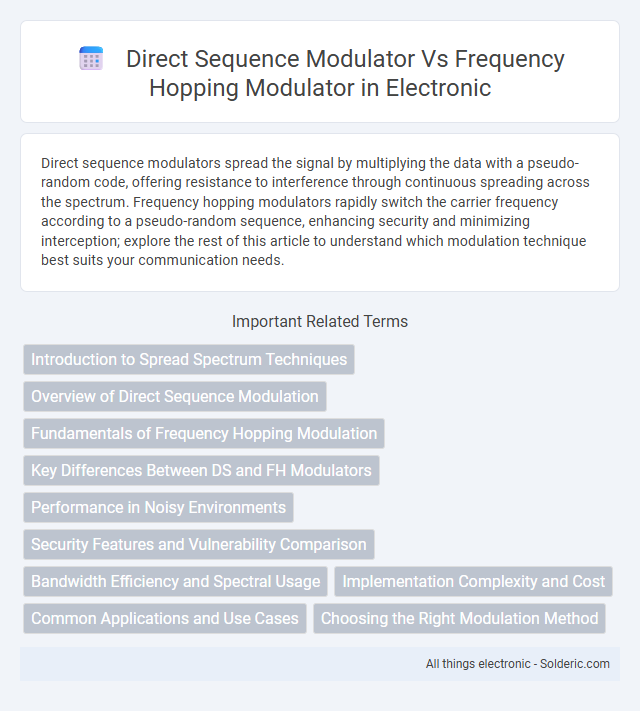Direct sequence modulators spread the signal by multiplying the data with a pseudo-random code, offering resistance to interference through continuous spreading across the spectrum. Frequency hopping modulators rapidly switch the carrier frequency according to a pseudo-random sequence, enhancing security and minimizing interception; explore the rest of this article to understand which modulation technique best suits your communication needs.
Comparison Table
| Feature | Direct Sequence Modulator (DS) | Frequency Hopping Modulator (FH) |
|---|---|---|
| Modulation Technique | Spreads signal by multiplying with a pseudo-random code sequence | Changes carrier frequency in a pseudo-random sequence |
| Spectrum Usage | Wideband spread spectrum with continuous signal | Switches among narrowband frequencies over time |
| Bandwidth | Wide bandwidth, determined by spreading code rate | Narrow bandwidth per frequency hop, but overall wide |
| Interference Resistance | Good resistance due to spreading gain | Highly resistant to narrowband interference |
| Synchronization | Requires precise code synchronization | Requires frequency hop pattern synchronization |
| Complexity | Moderate complexity in correlator design | Higher complexity due to frequency tuning |
| Applications | CDMA cellular networks, GPS | Military communications, Bluetooth classic |
Introduction to Spread Spectrum Techniques
Spread spectrum techniques enhance wireless communication security and reliability by spreading signals over a wide frequency band. A Direct Sequence Modulator multiplies the data signal with a pseudo-random noise code, creating a signal that appears noise-like and resists narrowband interference. In contrast, a Frequency Hopping Modulator rapidly switches the carrier frequency among many channels, improving resistance to jamming and eavesdropping, offering robust options for your communication system design.
Overview of Direct Sequence Modulation
Direct Sequence Modulation (DSM) spreads the signal by multiplying the data with a high-rate pseudo-noise code, enhancing resistance to interference and enabling multiple users on the same frequency band. This modulation technique offers robust performance in environments with narrowband interference and supports higher data rates compared to Frequency Hopping Modulation. Your communication system benefits from DSM's ability to provide improved signal security and reduced susceptibility to eavesdropping through continuous spreading of the transmitted signal.
Fundamentals of Frequency Hopping Modulation
Frequency hopping modulation involves rapidly switching the carrier frequency among many distinct frequencies according to a pseudorandom sequence, enhancing resistance to interference and eavesdropping. This technique spreads the signal energy over a wide bandwidth, improving security and robustness in wireless communication systems. Compared to direct sequence modulation, frequency hopping requires precise synchronization between transmitter and receiver to follow the frequency hopping pattern accurately.
Key Differences Between DS and FH Modulators
Direct sequence (DS) modulators spread the signal by multiplying data with a high-rate pseudo-random code, creating a wideband signal that offers resistance to narrowband interference and improved signal security. Frequency hopping (FH) modulators, in contrast, rapidly switch the carrier frequency across a sequence of channels based on a pseudo-random pattern, enhancing anti-jamming capabilities and robustness against frequency-selective fading. Your choice between DS and FH modulators depends on the application's tolerance for interference, desired security level, and the complexity of implementation.
Performance in Noisy Environments
Direct sequence modulators spread signal energy over a wide bandwidth, making them highly resilient to narrowband noise and interference, which improves performance in noisy environments. Frequency hopping modulators rapidly switch carrier frequencies according to a pseudo-random sequence, enabling them to avoid persistent interference and reduce the impact of fading. Both techniques enhance signal robustness, but direct sequence modulation offers superior resistance to continuous broadband noise, while frequency hopping excels against intermittent or frequency-specific interference.
Security Features and Vulnerability Comparison
Direct sequence modulators spread the signal over a wide frequency band using pseudorandom code sequences, providing resistance against narrowband interference and making unauthorized interception more difficult. Frequency hopping modulators rapidly switch carrier frequencies according to a known pattern, enhancing security by reducing susceptibility to jamming and interception but can be vulnerable if the hopping pattern is compromised. Your choice between these modulation schemes should consider the required level of protection against eavesdropping, with direct sequence offering better resistance to interception while frequency hopping excels in mitigating jamming attacks.
Bandwidth Efficiency and Spectral Usage
Direct sequence modulators offer high bandwidth efficiency by spreading the signal across a wide frequency band with a consistent spectral density, enabling robust communication within a fixed bandwidth. Frequency hopping modulators utilize spectral bandwidth more dynamically by rapidly switching carrier frequencies, reducing interference and allowing multiple users to occupy the same spectral region with minimal overlap. Your choice between these modulation techniques should consider whether consistent bandwidth usage or flexible, interference-resistant spectral allocation better suits your communication needs.
Implementation Complexity and Cost
Direct sequence modulators typically exhibit lower implementation complexity due to simpler spreading code generation and signal processing requirements, resulting in reduced hardware costs. Frequency hopping modulators demand more sophisticated frequency synthesis and rapid switching capabilities, increasing both design complexity and overall system cost. The choice between these modulators often hinges on budget constraints and desired performance in interference resilience.
Common Applications and Use Cases
Direct sequence modulators excel in secure communication systems and GPS technology by spreading signal bandwidth to resist interference and eavesdropping. Frequency hopping modulators are widely used in military communications and Bluetooth devices due to their ability to rapidly switch frequencies, enhancing resistance to jamming and multipath fading. Both techniques support wireless networks but target different performance needs, with direct sequence favoring robustness in noisy environments and frequency hopping optimizing frequency diversity.
Choosing the Right Modulation Method
Choosing the right modulation method between direct sequence modulator and frequency hopping modulator depends on the application's requirements for interference resistance and bandwidth efficiency. Direct sequence modulation offers high data rates and strong resistance to narrowband interference by spreading the signal over a wide frequency band with a pseudo-random code. Frequency hopping modulation provides robust security and better performance in multipath environments by rapidly switching frequencies, making it ideal for environments with dynamic interference and varying channel conditions.
Direct sequence modulator vs frequency hopping modulator Infographic

 solderic.com
solderic.com